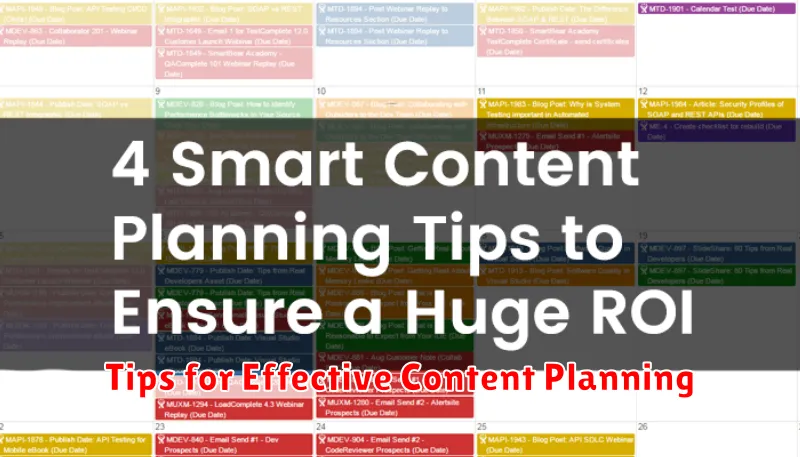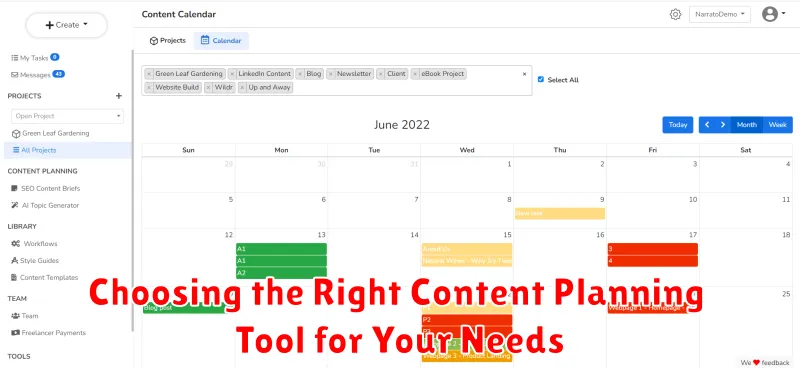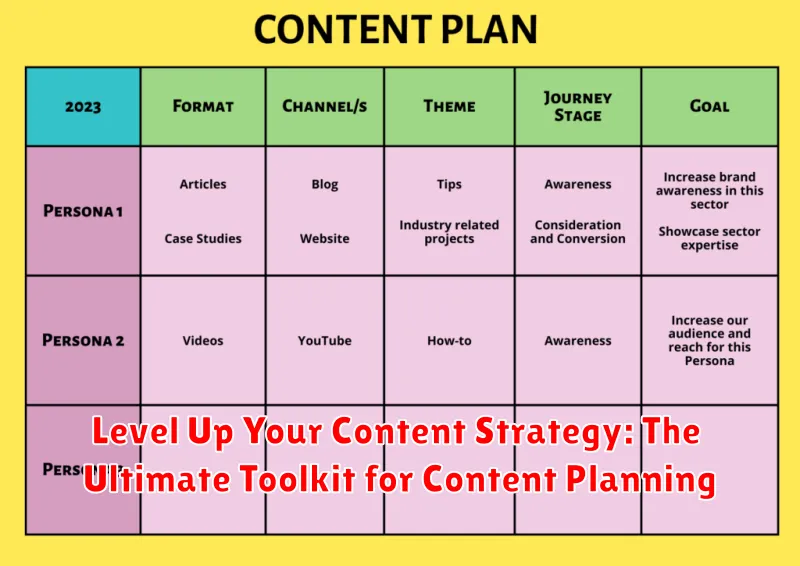In today’s digital landscape, a robust content strategy is no longer a luxury, but a necessity. Whether you’re a seasoned marketer or just starting out, mastering content planning is the key to engaging your target audience, driving conversions, and achieving your business objectives. This ultimate toolkit provides you with the essential resources and actionable strategies to level up your content strategy and stay ahead of the curve. Learn to create high-quality, impactful content that resonates with your audience and delivers measurable results.
This comprehensive guide will equip you with the knowledge and tools to effectively plan, create, and distribute compelling content. From keyword research and content calendars to performance analysis and optimization techniques, we’ll cover every aspect of the content planning process. Prepare to transform your content from a simple output into a powerful engine driving growth and success. Discover how to level up your content strategy and achieve your content marketing goals.
Understanding the Importance of Content Planning
In today’s digital landscape, a well-defined content strategy is crucial for success. Content planning forms the bedrock of this strategy, providing a roadmap for creating, distributing, and managing content effectively. Without a plan, your content efforts can become disjointed and fail to achieve desired results.
Content planning provides several key benefits. It ensures consistency by scheduling content creation and publication. This consistent output keeps your audience engaged and reinforces your brand presence. A strong plan also helps target specific audience segments with tailored content, maximizing impact and reach. Furthermore, planning allows for efficient resource allocation, ensuring your budget and time are used wisely.
By understanding the importance of content planning, you can lay the foundation for a successful content strategy that drives meaningful results for your business or organization.
Key Features to Look for in Content Planning Tools
Selecting the right content planning tool can significantly impact your content strategy’s effectiveness. Look for key features that streamline your workflow and maximize your content’s reach.
Editorial Calendar: A visual calendar is crucial for scheduling and organizing content. It provides a clear overview of upcoming posts, deadlines, and content themes.
Collaboration Features: If you work with a team, seamless collaboration is essential. Look for tools that allow for assigning tasks, sharing feedback, and managing approvals.
Keyword Research Integration: Boost your content’s visibility with tools that integrate keyword research capabilities. This helps you target the right audience and improve search engine optimization (SEO).
Content Performance Analytics: Track the success of your content with built-in analytics. Monitor key metrics such as engagement, reach, and conversions to optimize future content.
Platform Integrations: Seamlessly connect your content planning tool with your social media platforms and other marketing tools for efficient publishing and distribution.
Top Free Content Planning Tools for Beginners
Starting with a limited budget? Several free content planning tools offer excellent features to kickstart your content strategy. These tools provide basic functionalities for organizing your content calendar, brainstorming ideas, and tracking progress.
Trello, a popular project management tool, can be effectively utilized for content planning. Its visual interface, featuring boards, lists, and cards, allows for easy collaboration and task management. You can create a content calendar board, assign tasks to team members, and track the progress of each piece of content.
Google Sheets, a free spreadsheet program, is another excellent option. It provides a flexible platform for creating content calendars, tracking keywords, and analyzing performance metrics. With its collaborative features, multiple users can work on the same document simultaneously.
Asana, while offering paid plans, also provides a free version that’s suitable for individuals or small teams. This tool offers features for task management, collaboration, and progress tracking, making it useful for managing your content creation workflow.
Advanced Content Planning Tools for Professionals
For professionals seeking robust features and collaborative capabilities, advanced content planning tools offer a more comprehensive solution. These tools often integrate with other marketing platforms and provide in-depth analytics for data-driven decision-making.
Enterprise-grade platforms like Contently and Kapost offer centralized content hubs for managing the entire content lifecycle, from ideation and creation to publishing and analysis. These tools are ideal for large teams with complex workflows, facilitating seamless collaboration and streamlined processes.
Marketing automation platforms such as HubSpot and Marketo also include content planning modules. While primarily focused on automating marketing campaigns, these tools enable users to plan and schedule content alongside other marketing activities, ensuring a cohesive strategy.
For professionals focused on SEO performance, platforms like SEMrush and Ahrefs extend beyond keyword research to provide content planning features. These tools offer valuable insights into competitor strategies, topic trends, and content gaps, empowering users to create data-backed content that resonates with their target audience and ranks well in search results.
Integrating Your Content Plan with Your Overall Marketing Strategy
A successful content plan isn’t a standalone entity; it’s an integral part of your overall marketing strategy. Integrating your content plan ensures consistent messaging and maximized impact across all marketing channels.
Start by aligning your content goals with your broader marketing objectives. Whether it’s brand awareness, lead generation, or customer retention, your content should contribute to these overarching goals. This synergy amplifies your efforts and provides a unified brand experience.
Leverage your content across various marketing channels. Promote blog posts on social media, incorporate video content in email campaigns, and repurpose articles into downloadable resources. This cross-channel promotion extends your reach and reinforces your message.
Consistency is key. Ensure your brand voice, tone, and visual style remain consistent across all content and marketing channels. This creates a cohesive brand identity and fosters trust with your audience.
Finally, regularly analyze the performance of your integrated content strategy. Track key metrics, gather data, and adapt your approach based on the results. This iterative process allows you to continuously optimize your content plan for maximum effectiveness within your overall marketing ecosystem.
Measuring the Success of Your Content Plan
A successful content plan drives tangible results. Measuring these results is critical to understanding what’s working, what’s not, and how to optimize your strategy for better performance. It’s not enough to simply create content; you must track its impact.
Key metrics to consider include website traffic, engagement metrics (likes, shares, comments), lead generation, and ultimately, conversions (sales, sign-ups). Establish clear goals for each metric and regularly monitor your progress.
Analytics platforms are indispensable for measuring content success. Utilize tools like Google Analytics to track website traffic, referral sources, and user behavior. Social media analytics dashboards provide insights into engagement and reach.
Regularly review your data and identify trends. Are certain types of content performing better than others? Which channels are driving the most valuable traffic? Use these insights to refine your content plan and focus your efforts on the most effective strategies.
Tips for Effective Content Planning

Define clear objectives. Before creating any content, establish what you want to achieve. Are you aiming to increase brand awareness, generate leads, or drive sales? Clearly defined goals will guide your content creation process.
Know your audience. Understanding your target audience—their demographics, interests, and pain points—is crucial. Tailor your content to resonate with their needs and preferences.
Maintain a consistent content calendar. Regularly publishing content keeps your audience engaged and improves your search engine visibility. A content calendar ensures a consistent flow of valuable material.
Repurpose existing content. Extend the lifespan of your content by repurposing it into different formats. Turn a blog post into an infographic, a webinar into a series of social media posts, or compile multiple articles into an ebook.
Analyze and optimize. Regularly review your content performance metrics to understand what’s working and what isn’t. Use this data to refine your strategy and improve your results.
Future Trends in Content Planning Tools
The landscape of content planning is constantly evolving. Artificial intelligence (AI) is poised to play a larger role, automating tasks like content generation and topic suggestion. Expect more tools to incorporate AI-powered features for improved efficiency.
Semantic search is another key trend. Tools will likely leverage semantic understanding to refine keyword research and topic clustering, ensuring content aligns more effectively with user intent.
Integration with other marketing platforms will become increasingly seamless. Content planning tools will connect directly with social media management, email marketing, and analytics dashboards, streamlining workflows and providing a more holistic view of content performance.
Finally, expect a greater emphasis on real-time collaboration. Tools will offer more robust features for team communication and project management, facilitating smoother content creation and distribution processes.
Choosing the Right Content Planning Tool for Your Needs

Selecting the appropriate content planning tool can significantly impact your content strategy’s effectiveness. Several factors should guide your decision-making process.
First, consider your budget. Free tools may suffice for basic needs, while premium tools offer advanced features that justify their cost for larger teams or complex campaigns. Evaluate your team’s technical skills. Some tools require a steeper learning curve than others. Choose a platform that aligns with your team’s capabilities to ensure smooth adoption.
Integration with existing marketing tools is crucial. A seamless workflow between your content planning tool and other platforms enhances efficiency. Finally, analyze the specific features offered by each tool. Prioritize features that align with your content goals, such as workflow management, SEO analysis, or social media scheduling. By carefully assessing these factors, you can select the optimal tool to streamline your content planning process and achieve your content marketing objectives.

